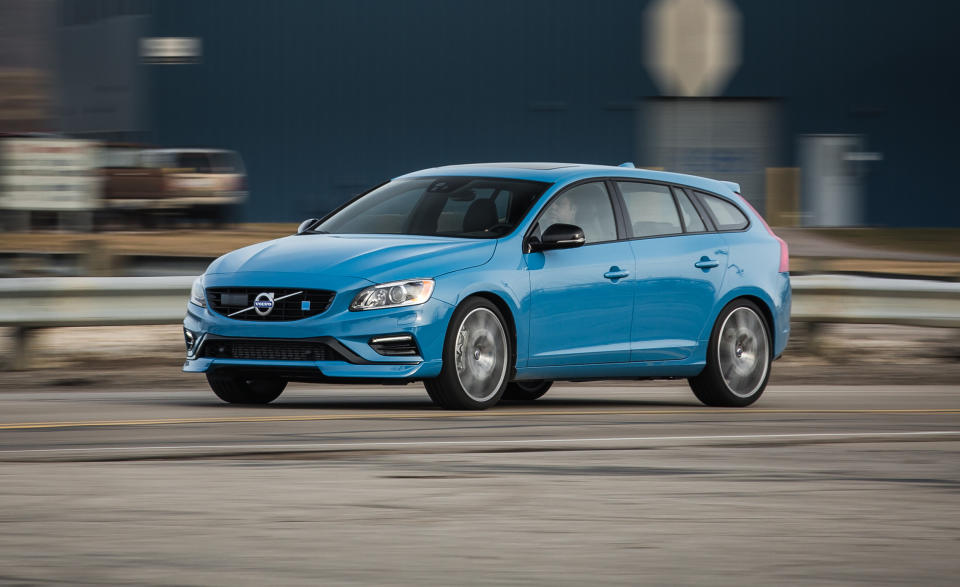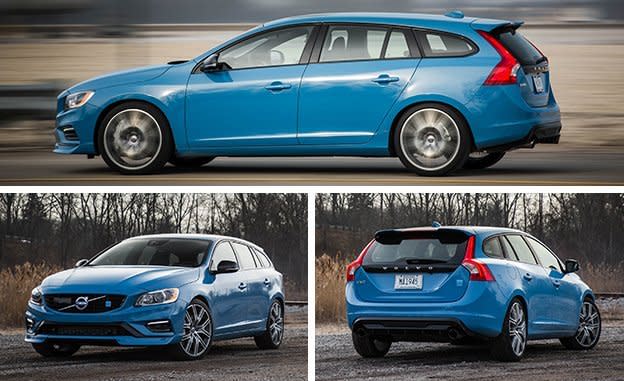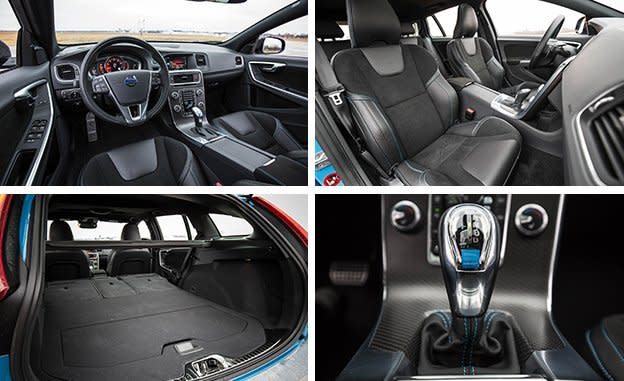2017 Volvo V60 Polestar

There could not exist a greater chasm between the first impression given by the name Polestar and the Volvo V60 variant that wears it. This unassuming Volvo hatchback is such an introvert, it might suffer from social anxiety.
Indeed, merely looking at the 2017 V60 Polestar won’t be enough to let most observers grasp exactly what it is. To clear things up, it is a $62,595 wagon sized toward the small end of the mid-size class, which has been given a performance makeover by Volvo’s in-house tuning arm, Polestar. Even the car-literate person could miss the special 20-inch wheels, rubber-band-thin performance tires, and tiny blue Polestar badge in the grille. Understated is what the V60 Polestar does best—our test car’s Rebel Blue paint aside—and it’s also why we like this wagon so much.

The Polestar is exceedingly rare, with Volvo building just 750 sedans and wagons annually since its introduction for 2015. Initially, the wagon and its S60 Polestar sedan sibling bristled with 345 horsepower generated by a turbocharged 3.0-liter inline-six driving all four wheels. For 2017, Volvo has chucked that engine, along with its aging six-speed automatic transaxle, in favor of a 362-hp turbo- and supercharged 2.0-liter inline-four and an eight-speed automatic. If that doesn’t seem like enough power for the V60’s price, well, that’s why Volvo isn’t bringing many of these Polestars to the land of the Hellcat and the Big Mac.
And the Net Result Is . . .
While the changes for 2017 include restyled wheels, new brake rotors, a retuned all-wheel-drive system, and revised steering, the new engine is the headliner. Even though we never tested a V60 Polestar with the old engine, we did test its S60 sedan counterpart; compared with that car, the new V60 is 0.1 second quicker, both to 60 mph (for a speedy 4.4-second run) and to the quarter-mile marker, which it hits in 13 seconds flat. These performance improvements are in spite of the V60’s 80-pound weight penalty relative to the 2015 S60.

The new engine appears also in the XC90 SUV and the 90-series sedan and wagon, although Polestar extracts an extra 46 horsepower and 52 lb-ft of torque for this application. At low rpm, the supercharger helps spur the four-banger, the effect being instant torque and a hint of blower whine in the cabin. Keep in the throttle, and through the midrange and at higher rpm the turbocharger takes over, a faint whistle accompanying its work. The combined forced-induction strategies give the four-cylinder sharper response than the old inline-six, and its midrange punch is strong.
Some of the newfound pep can be credited to the eight-speed automatic, which generally comports itself better than the slushy six-speed. Nudging the shift lever to the S gate activates the Polestar’s Sport mode, calling up a spicier powertrain program, deepening the exhaust note at idle (by raising the idle speed to about 1000 rpm), and adding some starch to the steering. Here, the eight-speed cracks off premonitory downshifts when braking into a corner, and it more aggressively holds lower gears. Slapping at the tiny shift paddles or the shift lever now summons relatively quick up- and downshifts with rev-matching, while the six-speed would just sort of blend from gear to gear with no backup from the throttle when shifted manually.

The Turning Point
As before, the Polestar rides on Öhlins dampers with fancy valving that allows for different high-speed (like a pothole impact) and low-speed (spirited driving) damping. The result is quick cycling over sharp impacts without ruining the ride quality, as well as firm composure in corners. The overall chassis setup is still sporty, although our test car seemed to round off the nastier cracks and potholes as well as any car on 20s we can remember.
The Polestar goes through corners with an overwhelming sense of grip. A snowy skidpad prevented us from recording lateral acceleration, but the 2015 S60 held on for a sports-car-like 0.91 g. Volvo retuned the clutch-pack all-wheel-drive coupler to apportion more torque to the rear axle and to do so sooner. As before, stomping on the gas at midcorner sets all four tires clawing at the pavement, yanking the Polestar through, only now the effect is greater. There isn’t enough rear bias to generate power-on oversteer, and overall, the chassis suffers from a mild case of understeer. Well, as long as you’re on the throttle; otherwise, the Polestar profoundly understeers in tighter bends.
Does the new turbo- and supercharged engine transform the V60 Polestar? Hardly, and we will miss the old inline-six’s BMW-like voice, which has been replaced by an angry vacuum-cleaner sound. Nevertheless, we appreciate the small adjustments Volvo made to the rest of the package, from the quicker-acting all-wheel drive to the steering revisions that send more road feel to the driver’s hands. And as before, the best way to understand the Polestar is to drive the Polestar.
Specifications >
VEHICLE TYPE: front-engine, all-wheel-drive, 5-passenger, 4-door hatchback
PRICE AS TESTED: $62,595 (base price: $62,595)
ENGINE TYPE: supercharged, turbocharged, and intercooled DOHC 16-valve inline-4, aluminum block and head; direct fuel injection
Displacement: 120 cu in, 1969 cc
Power: 362 hp @ 6000 rpm
Torque: 347 lb-ft @ 3100 rpm
TRANSMISSION: 8-speed automatic with manual shifting mode
DIMENSIONS:
Wheelbase: 109.3 in
Length: 182.5 in
Width: 73.4 in Height: 58.4 in
Passenger volume: 94 cu ft
Cargo volume: 28 cu ft
Curb weight: 3966 lb
C/D TEST RESULTS:
Zero to 60 mph: 4.4 sec
Zero to 100 mph: 10.9 sec
Zero to 130 mph: 20.0 sec
Zero to 150 mph: 31.9 sec
Rolling start, 5–60 mph: 5.1 sec
Top gear, 30–50 mph: 2.6 sec
Top gear, 50–70 mph: 3.3 sec
Standing ¼-mile: 13.0 sec @ 108 mph
Top speed (governor limited, C/D est): 155 mph
Braking, 70–0 mph: 154 ft
FUEL ECONOMY:
EPA combined/city/highway driving: 23/20/27 mpg
C/D observed: 19 mpg

 Yahoo Finance
Yahoo Finance 